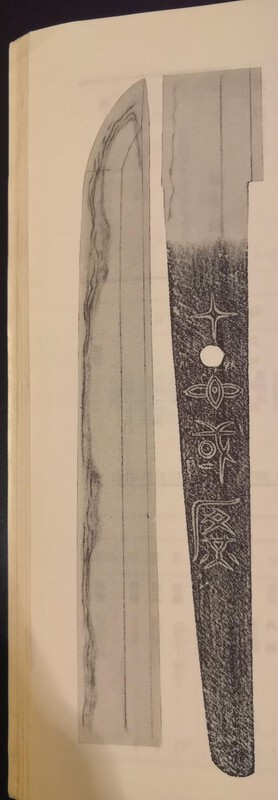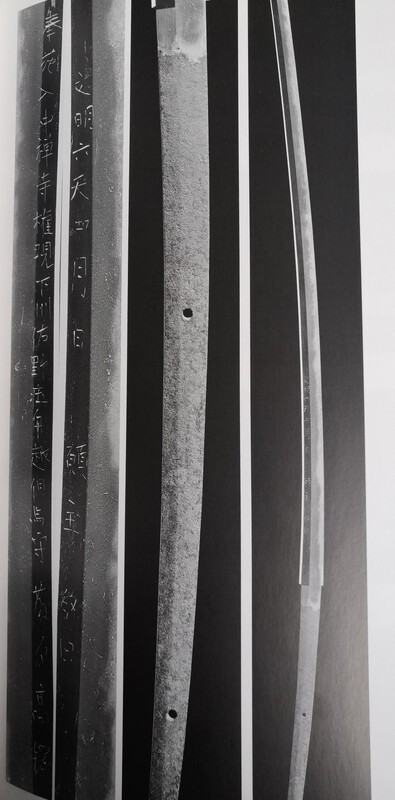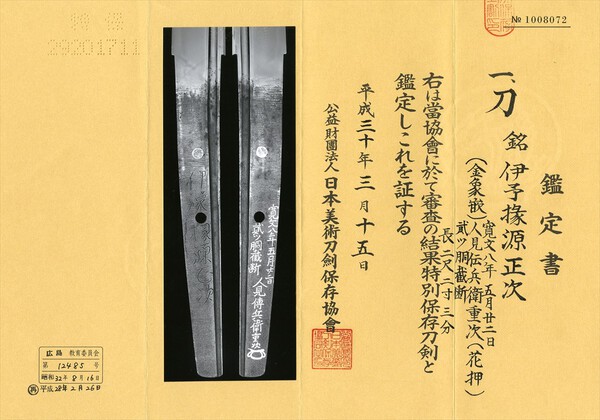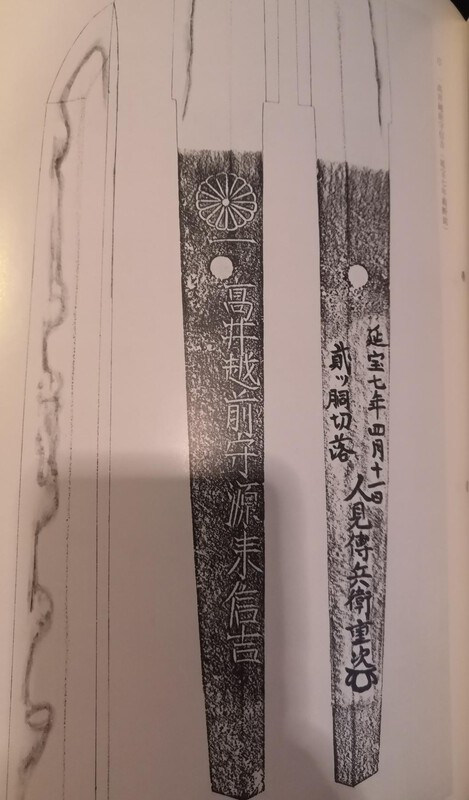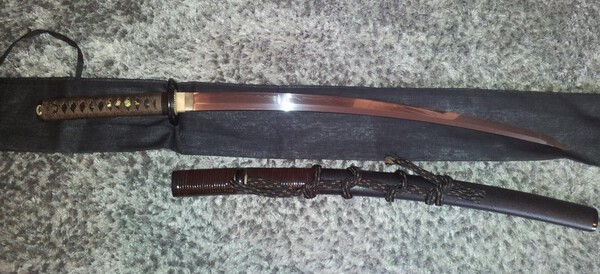-
Posts
2,122 -
Joined
-
Last visited
-
Days Won
37
Content Type
Profiles
Forums
Events
Store
Downloads
Gallery
Everything posted by Jussi Ekholm
-
Well I am not too hot thread starter but as I encountered this in old NBTHK magazine I thought I'd share this one. Like the thread title says. Have you seen something like this before? Short and sweet opening post. Of course I do have the article but I've struggled to figure out what should something like this be called. I haven't found a term in any of my glossaries. Maybe it will spark some discussion who knows...
-

carving and writing on blades
Jussi Ekholm replied to Steffieeee's topic in General Nihonto Related Discussion
I posted that example above as it has writing (instead of horimono characters) on the blade which is very rare. The sword is an ōdachi in the collection of Futarasan-jinja. It is mumei attributed to Sōshū Masahiro and Nanbokuchō period. The blade length is 117,8 cm and nakago is 53,1 cm. Here is the writing on the blade. I do believe the main point of it is it was dedicated to the shrine 1474. Someone more proficient in Japanese language would be able to translate it. 奉施入中禅寺権現下州佐野庄舟越但馬守藤原高綱 / 文明六天四月日願主敬白 I believe pretty much all of the examples of tōshin-kiritsukemei I have seen have been on swords that are in the various shrines. In the masterpieces from Futarasan-jinja book 15 out of 34 swords featured have this type of writing on the blade. -

Wanted: Tōken Bijutsu (Nbthk Magazine) Issues
Jussi Ekholm replied to Jussi Ekholm's topic in Wanted to Buy
Well I've been continuing my hunt at Japanese sites. There is just so much amazing stuff available in there it is hard to keep control about buying stuff... I am still looking few years of NBTHK magazines if someone in Europe might have them. I haven't found these for sale in Japan in a long while (outside huge lots). Sometimes they can be found in huge lots but I don't need the 20+ years of magazines in the package as I already have them, just the few years that I am missing. 1985 - Issues 336 to 347 1986 - Issues 348 to 359 Same offer 50€ per year and I'll pay the shipping is still up for these two years. Now I might be tempted to buy very early magazines pre-100 too depending on the price. But as they tend to be quite expensive I am not sure if I have the budget for them right now... -

carving and writing on blades
Jussi Ekholm replied to Steffieeee's topic in General Nihonto Related Discussion
Here is an example of very rare thing, that is an added on writing on the blade itself. I believe it is usually called tōshin-kiritsukemei or at least that is what I personally call it now. I haven't found it listed in any of my glossaries but Japanese descriptions of specific swords usually state it as such as far as I can translate the text by myself. This was a mystery for me for a long while and it might be for some others too so I thought I'd share it. -
As I was doing the translation and got Omote side I found your sword online. I got (X)八(幡?) 西條臣矢野俊一/ 為山本守信君作 and it seems to be Tokubetsu Hozon sword that is listed at Nihonto AU: https://nihonto.com.au/product/toshikazu-katana-with-cutting-test-and-owners-name-nbthk-tokubetsu-hozon/
-
I hope my comment was not taken negatively. I was reading Markus' Tameshigiri book and it is stated that while 2 & 3 body tests were fairly common, results with more than 3 bodies are absolute rarity. I am not yet too well versed in cutting tests so I cannot comment much more. I do agree that sometimes NBTHK seems to take a conservative stand. Here are two more examples of Hitomi Denbei Shigetsugu cutting tests for reference.
-
I think the downside of those c. 1000$ eBay Hozon wakizashi from Japan is usually the condition. I've watched many of them over the years as indeed they seem to be good deals for the amount spent. I've just always held the trigger as the swords at eBay I see as most interesting ones are in such condition that in the end I have never seen buying as a good option for me. I feel like those swords are going for about their value in the current market, and the good thing about that is that if you get one you'll most likely get about your investment back. You most likely won't find hidden gems coming out of Japanese eBay dealers. However you can get some reasonable swords for reasonable prices.
-
Would it be possible to see a picture of the Tokubetsu Hozon paper? To my eye looking at the small pic it seems to have と金象嵌がある - to kinzōgan ga aru in brackets, which to me indicates NBTHK are having some reservations about the kinzōgan as they've added that line in brackets.
-
I believe you are correct Steve. There seems to be vertical stroke going through the upper horizontals.
-
I think it is Nobumichi - 信道作 These WW2 signatures are often more difficult for me to read than the older ones. Here is another example: https://nihontoantiques.com/project/gunto-fss-829/
-
Could you provide a better picture of the side with date as this seems very blurry. Year might be 弘化元年 1844 I would approach the signature with caution. The famous Nankai Tarō Tomotaka signed Tomotaka with 朝尊 while your sword has different kanji (same reading though) for both. 友高 is Tomotaka but I don't know any smith signing with this combination. Unfortunately I don't know the late smiths too well so I cannot give much more info.
-

Looking for a nice Chinese Repro sword max. 400 EUR
Jussi Ekholm replied to vajo's topic in Wanted to Buy
I've owned few repros from YarinoHanzo and I like their option for custom stuff. I've been in contact with Chinese forges/resellers but I have always had some communication problems, so I have never bought anything custom directly from the forge. YarinoHanzo offers nice mix of very reliable customer service and customization options. Now here is a "trick" I've used, I have ordered only when they are having a discount offer. I have a custom ōdachi now on order from them and I got it during -X% (don't remeber the sale percentage but it was very big as the total price is now so low) offer on their extreme customs. To be honest I am shocked how affordable the customs are. I am getting 95 cm ōdachi with custom tsuka & tsukamaki delivered to me for c. 300€'s. As it will be 95 cm blade with 3,6 cm motohaba they will need to make completely custom saya for it for example... As well as tsuka & other stuff too. Here is my last custom I got from them in 2014. I was aiming for late Muromachi katate-uchi with Higoish koshirae as well I could with c. 300€ budget. I thought it came out pretty decent in the end. I just knew they wouldn't make the nakago short enough for my liking so I sawed a bit off after having it for a while. -
Thanks for posting this Peter. That is an amazing collection, I spent my weekend going through it sword by sword. If all goes planned (and things will calm down back to normal) I will be in June in Tokyo, I definately will try to go to a day trip to Nagoya to visit this museum.
-
You are correct Kirill, I guess you could say the statistics above are top tier biased as many of them are above Jūyō. The data is skewed and that is the stuff in museums and top collections. Signed Aoe, Signed Rai, top tier Sōshū etc. this is not the stuff featured in average collections. That stat above should have about all of the Kokuhō, JūBu and JūBi swords included, so it is definately biased. I would love to have access to NBTHK databank about Hozon and Tokubetsu Hozon swords and databases similar to that but unfortunately it is quite difficult to find lots of data on swords below Jūyō as they are not too commonly published. So on Hozon & TH I have to rely on data that I can find from online sword shops. However you can find the Bunkazai etc. published on various books, featured in magazines, online info about them and so on.
-
Here are some statistics about surviving swords that are pre 1450, of course the data is bit skewed and compeletely missing late Muromachi... The sample size is c.9000 swords now. I am not that skilled with maths and it is not in my interests but here are some numbers that should be correct to my data. All of the numbers are rounded up. Yamashiro - 15% (out of which 58% signed) Yamato - 8,5% (out of which 20% signed) Sōshū - 5,5% (out of which 32% signed) Mino - 4,5% (out of which 12% signed) Bizen - 38,5% (out of which 62% signed) Etchū - 3,5% (out of which 30% signed) Bitchū - 5,5% (out of which 56% signed) Bingo - 3% (out of which 32% signed) Chikuzen - 4,5% (out of which 36% signed) Others - 11,5% Some explanation why this might be very different from statistics/calculations that span until the end of Muromachi period. As Paul explained some of the reasoning earlier you'll see Yamashiro being really high in this percentage but the tradition faded after early Muromachi (and my data collection ends there). For Yamato I have only the 5 main traditions within the Yamato province, not counting schools with obvious Yamato influnce to it. For Sōshū see Pauls explanation how it faded atfer this period. Mino hadn't really started to thrive this early, and that is why it is so minor in my data, also the great amount of mumei work compared to later Muromachi Mino stuff that often bears a signature. Bizen always huge by numbers compared to peers. Some others I inculded that I thought were significant, Bitchū is Aoe school in this case, faded out after early Muromachi. Etchū has basically Norishige/Gō/Uda and Uda continued as a production center in later Muromachi too. Bingo has early Mihara school and Hōkke, both which continued into later Muromachi too. Chikuzen has Sa school (and it's predecessors) and Kongōbyōe. I thought adding in the % signed would be a fun one but here is a thing with that one. It will go lower as I keep adding more swords... As the reality is that signed top tier work from pre 1450 is rare, you are bound to find lot more and more mumei stuff. Also to be noted most of the stuff listed here is not for "the average" collector. As in the c. 9000 examples only c.1200 are below Jūyō level and lot of the stuff is basically unobtainable.
-
I noticed the sword immidiately after it was posted online as it ticks several boxes for me (even though it is way out of my range). I think Michael gave an excellent analysis on it above. My personal thing with this is the wide shape that the sword has. Yes it is short at 66,9 cm but that is quite common (shortish length) for really wide swords. It is rare to find Nanbokuchō swords with 3,3 cm+ motohaba. As the stats show the sword width going from 3,4 to 2,7 cm. For a person like me something like few mm in motohaba width are extremely important (even though it most likely is foolish). So far I have tracked down 43 mumei katana with attribution to Ōmiya Morikage and this one seems to be the second widest in general form. There is even more impressive one Jūyō 16 that is 71,0 cm and goes from 3,4 to 3,0 cm. And like Michael said above there is a huge gap between Morikage attribution and Ōmiya attribution in general. I am not totally understanding the koshirae. Given I am not a koshirae collector it has me really puzzled. As you can see the omote side of it is not like in regular koshirae that you carry edge downwards. Yet it does have a full set of ashi and it seems like regular tachi koshirae. I've seen some handachi koshirae that have various type of ashi. It might sound crazy but something as minor as starting side of tsukamaki is bugging me a lot...
-

Advice to which smith or line to study more of.
Jussi Ekholm replied to BjornLundin's topic in Nihonto
I'll let other to evaluate artistic qualities and offer assistance in identifying on that field. I'll give some info about the signature if it is indeed the same sword that was on earlier threads and it is dated. Like Moriyama-san identified in earlier thread the signature and dating on your sword is 修理亮盛光 / 応永拾年二月日 = Shūri no Suke Morimitsu / Ōei 10 nen ni gatsu hi (1403). My focus in here is in the kanji 拾 used for 10. It might not be common knowledge but after looking at thousands of signatures my own analysis shows the use of this kanji for 10 in years did not appear (I haven't yet found an example) before Bunmei (1469-1487). The earliest dated signatures I've seen this appear are Tadamitsu signature 1478 and Katsumitsu & Munemitsu sword dated 1486. I have recorded nearly 1000 dated signatures pre-1450 and this kanji does not appear in any of them. Most commonly this rare kanji appears in Keichō era (1596-1615) signatures. Of course this is kinda extremely specific info that is impossible to know for beginning collectors and pretty much to most collectors who have not been extremely fixated with mei. I think this sword is much better than the Sukesada you posted earlier. As you said in the opening post you can see characteristics of this sword much better than in the Sukesada. -
Some very interesting discussion with great views. I do not generally like to talk about monetary value as I do try to appreciate the swords in other ways than pure money. I think I have to on the bit about Jitsua as I've been kinda keeping eye on them. As I do have a personal thing for these less refined old schools (Hōjū, Sairen&Jitsua, etc.) they are close to my heart. Here is the thing about the signed Tokubetsu Jūyō Jitsua tachi that is for sale at Matsumoto for 20M. It came to the site originally with Jūyō papers from session 62. The sword was priced 10M yen back then, now is the passing TJ worth a 10M yen... Is the market ready for it at 20M? As I don't collect at that level I have no idea... I just know that signed tachi by Jitsua are incredibly desirable in rarity view. Here is the rundown on Jitsua tachi that I have info on so far. The only Ubu zaimei tachi by Jitsua is Jūyō Bunkazai and it is dated for 1333. It is also the only Bunkazai by this smith I know for certain. The other dated tachi is dated for 1335 by orikaeshi mei, I know for sure this is Jūyō Bijtusuhin but another source has listed this also as Bunkazai (I cannot confirm that as a fact yet as this was not listed in Bunkazai book but I now know not every Bunkazai was listed in that book). There are also 2 other signed Jūyō Bijutsuhin tachi. So out of the total 7 tachi, 4 are pretty much unobtainable. Now out of the remaining 3 signed ones 2 are now rated Tokubetsu Jūyō and 1 is "just" Jūyō. As for the mumei blades attributed to Jitsua, they do tend to go Jūyō as I've only found few Tokubetsu Hozon papered ones. However their number too (mumei Jitsua) is small in general. For the small data that I have on them mumei Jūyō Jitsua usually run between 2M to 4M yen. Now I must admit I am not extremely well versed in top tier mumei swords and fine appreciation points that need to be considered with them. I do hope to train myself in that over the years in future. There is just so much stuff that I need to learn about high & top tier mumei swords. I do enjoy Kirills approach of seeking signed swords by lesser known smiths. That is similar to my own interests too as I know top stuff will be unobtainable. I am also happy that Kirill mentioned Hōjū as it is among my favorite schools, and for that school I have lot more swords down than for just Jitsua. Unfortunately I don't have time to jump to that today.
-
As you asked for a sword group I can recommend NBTHK Scandinavia as a member: https://nbthkscandinavia.wordpress.com/You'll find experienced folks in there who can offer a lot of assistance. Group meets up in Stockholm area but hit them mail and let them know about you. Now as for the sword I will combine the info from both threads in this reply. I do hope this is not a discouraging post so I will try to have some positive thoughts in here too and not be too negative. There were lots of Sukesada smiths working during the latter part of Muromachi period in Bizen province. Unfortunately the majority of them were not notable smiths. For Sukesada you generally are looking for some of the "named" ones Hikobei, Hikozaemon, Yosōzaemon, Genbei, and there are some others too. Those are the reknown Sukesada smiths that you are after if you want to focus on top of the Sukesada lineage. Many of the regular Sukesada swords were just made to use and often massproduced in large numbers. When I look at your sword it is c. 65 cm blade with fairly short nakago (tang). Combination like this was very common in latter part or Muromachi starting from the very late 1400's up until the end of Muromachi period but nearing the end of Muromachi the swords were already getting slightly longer again in general. Combine this with what looks to me as quite crude 2 character mei Sukesada I'd think this was a "massproduced" sword from late Muromachi period by Bizen Sukesada smiths. Unfortunately when looking at the sword the current condition seems to be very rough. While not the best understood in looking at online pictures as a beginner to this hobby here are some references that I knew I'd find immidiately. First one will be your average Sukesada in good condition and second one will be by reknown smith Yosōzaemon Sukesada https://www.aoijapan.com/katana-bishu-osafune-sukesada-eisho-10-nen-8-gatsu-hi/ https://iidakoendo.com/6367/ I believe the papers on your sword are from Juho Token Kenkyukai, which unfortunately do not carry commercial value in the market. Now that does not mean they are wrong in this particular case. I do think they are quite correct as the smith is most likely late Muromachi Bizen Sukesada as they state. Now will it be Eishō,Tenbun or Tenshō that would be very difficult to say for me especially in the current state and even in pristine state. You have a piece of history in this sword. However restoring a sword like this might not repay the investment as there are lots and lots of these in the market. I do hope you enjoy this hobby and your stay here in this forum. I am sure the guys in Sweden will give you a warm welcome too if you contact the Scandinavian branch. Ask all the questions you want and I hope we can be of assistance.
-

Another Signed Blade from WWII
Jussi Ekholm replied to MacTheWhopper's topic in Translation Assistance
To me it looks like Kanetsugu 兼継 and 昭和十六年 Unfortunately I am not well versed in WWII era smiths, but there are few Kanetsugu listed with these characters. -
It looks like late Muromachi Bizen Sukesada, sayagaki mentions Tenbun 天文 1532-1555 as period.
-
I am enjoying this discussion greatly and I thought we can maybe continue this in another specific thread so I am opening one for it. First of all I am super happy you pointed me to Dmitry's regarding the Hiromitsu tachi. Unfortunately I haven't yet been able to get the book but as Dmitry opened his Museum website the sword is featured in there. And I was stunned to read the whole story about the sword, as before that I had just listed it for myself as smith unknown Sōshū from 1353 as I encountered it in Jūyō Bijutsuhin book. The further explanation on the sword and NBTHK designations are real gems. Now when it comes to importance of the signatures, sword like that is in the top level. While the signature is still only partial it allows the experts to recognize it. I know I've talked with many members how I personally valuate authentic signature often above the condition. Having a signature like that is like a holy grail. I know we had the signed Jitsua in another thread and I agree with your comment that in the signature amounts for huge amount of the price compared to similar mumei sword. The reason why I personally value something like signed Jitsua tachi so highly as I've been able to find only 7 signed tachi (2 with date) and 1 signed tanto. I agree that the further down in history you are going the facts and legends can start to mix up a bit as the information is so scarce. So accurate dating will be very difficult and you will have to give certain leeway to items.
-
I think we are straying from the original subject but as I feel it is interesting to discuss these things I'll continue a bit. I was just reading Nihonto Koza the other day and there was a point made that for Akihiro and Hiromitsu mumei katana don't generally been historically attiributed to them. For Hiromitsu I know 2 mumei katana and both are Bijutsuhin and for Akihiro 2 mumei katana that are Bunkazai. As both of them have a lot of signed shorter swords still remaining the lack of mumei swords is possibly due to avoiding attributing mumei katana to them. Similar thing with Shintōgo Kunimitsu, there are lots of signed pieces by him remaining, yet I haven't seen mumei sword attributed to Shintōgo Kunimitsu yet. There are few that are attributed to Shintōgo Kunihiro and Shintōgo in general. Now you got the opposite with Yukimitsu, Masamune and Sadamune, signed pieces are incredibly rare but there are lots and lots of mumei attributions to them. I know Darcy has been saying for years that it is extremely important to understand there are differences within the same mumei attribution. I also remember Wim said in other thread that for Jūyō items it is important to read the description to understand why the NBTHK made the call they did. Of course for items below Jūyō we don't have that information readily available so we must try to study ourselves. I know that shortening some of the large Nanbokuchō swords makes us miss a lot of original signatures on long swords but here are some smiths outside major 5 traditions who have relatively large amount of signed work remaining. Bungo Yukihira (Heian - Kamakura), Sa Yasuyoshi has many signed short swords remaining (Nanbokuchō), Hōki smiths have relatively high amount of signed tachi remaining (Heian - Kamakura), Mihara Masahiro (Nanbokuchō - Ōei), Aoe smiths in general have lots of signed swords remaining (Kamakura - Nanbokuchō). Now the numbers I am talking about are not huge by any numbers that is why I am using the term relatively.
-
I think Han Bin Siong was of course correct, I think I would have greatly enjoyed meeting him. I am still missing bit from the magical 10k mark and I have something planned when I reach that. And my stats will be slightly skewed as I have my own idea what I am after and data what I am needing for it. For the specific time frame I am after I am including everything from Kokuhō to Hozon, and even including some items with other provenances. I should have now about the great majority of Japanese government authorized swords that are fitting to my interest. I know I am still missing some (maybe a lot) Prefecture Bunkazai and City Bunkazai items. The numbers that Han Bin Siong had in his paper very strongly correlate the data I have in total (even though he had just Jūyō swords). It seems in my database c. 39% is Bizen and Yamato is only bit over 8% at the moment. For the c. 750 Yamato swords I have, only 156 of them have mei (partial, orikaeshi, gaku included) and 4 are just fumei. That leaves about 590 mumei Yamato blades, and given the circumstances as I have already went through most of high level items the amount of mumei will only increase and mei will become even more of a rarity. I already know many of the upcoming ones as I go onward in Jūyō but they will be few in number compared to mumei ones. But signed Yamato swords (with the small exception of Tegai Kanenaga) are very rare in general.
-
Paul was this the Shikkake that was featured at Samurai Art Expo 2018? I cannot go into finer details that separate different Yamato attributions from each other but I can offer some statistical data as I've been tracking swords down for many years. It shows something about the attribution of naoshi a bit. So far my data group for Yamato swords is about 750 swords. For Senjuin there is 1 Tokubetsu Hozon naoshi with partial mei remaining and specification in brackets to Nanbokuchō period. For Taima so far I have 5 naoshi listed. So far 0 naoshi for Tegai. So far 0 naoshi for Hōshō. Then there is Shikkake. I have 1 signed and dated naginata for Shikkake Norinaga, 3 naoshi with mei and 1 mumei for Norinaga. For Shikkake in general I have 1 mumei ubu naginata and 15 mumei naoshi blades. Lastly I have 7 mumei naoshi with Yamato Shizu attribution.


